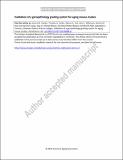| dc.contributor.author | Snyder, Jessica M. | |
| dc.contributor.author | Snider, Timothy A. | |
| dc.contributor.author | Ciol, Marcia A. | |
| dc.contributor.author | Wilkinson, John E. | |
| dc.contributor.author | Imai, Denise M. | |
| dc.contributor.author | Casey, Kerriann M. | |
| dc.contributor.author | Vilches-Moure, Jose G. | |
| dc.contributor.author | Pettan-Brewer, Christina | |
| dc.contributor.author | Pillai, Smitha P. S. | |
| dc.contributor.author | Carrasco, Sebastian E. | |
| dc.contributor.author | Salimi, Shabnam | |
| dc.contributor.author | Ladiges, Warren | |
| dc.date.accessioned | 2022-03-14T17:52:18Z | |
| dc.date.available | 2021-09-20T17:17:08Z | |
| dc.date.available | 2022-03-14T17:52:18Z | |
| dc.date.issued | 2019-08 | |
| dc.date.submitted | 2019-04 | |
| dc.identifier.issn | 2509-2715 | |
| dc.identifier.issn | 2509-2723 | |
| dc.identifier.uri | https://hdl.handle.net/1721.1/131451.2 | |
| dc.description.abstract | Abstract
An understanding of early-onset mechanisms underlying age-related changes can be obtained by evaluating changes that precede frailty and end of life using histological characterization of age-related lesions. Histopathology-based information as a component of aging studies in mice can complement and add context to molecular, cellular, and physiologic data, but there is a lack of information regarding scoring criteria and lesion grading guidelines. This report describes the validation of a grading system, designated as the geropathology grading platform (GGP), which generated a composite lesion score (CLS) for comparison of histological lesion scores in tissues from aging mice. To assess reproducibility of the scoring system, multiple veterinary pathologists independently scored the same slides from the heart, lung, liver, and kidney from two different strains (C57BL/6 and CB6F1) of male mice at 8, 16, 24, and 32 months of age. There was moderate to high agreement between pathologists, particularly when agreement within a 1-point range was considered. CLS for all organs was significantly higher in older versus younger mice, suggesting that the GGP was reliable for detecting age-related pathology in mice. The overall results suggest that the GGP guidelines reliably distinguish between younger and older mice and may therefore be accurate in distinguishing between experimental groups of mice with more, or less, age-related pathology. | en_US |
| dc.publisher | Springer Science and Business Media LLC | en_US |
| dc.relation.isversionof | https://doi.org/10.1007/s11357-019-00088-w | en_US |
| dc.rights | Article is made available in accordance with the publisher's policy and may be subject to US copyright law. Please refer to the publisher's site for terms of use. | en_US |
| dc.source | Springer International Publishing | en_US |
| dc.title | Validation of a geropathology grading system for aging mouse studies | en_US |
| dc.type | Article | en_US |
| dc.contributor.department | Massachusetts Institute of Technology. Division of Comparative Medicine | |
| dc.relation.journal | GeroScience | en_US |
| dc.eprint.version | Author's final manuscript | en_US |
| dc.type.uri | http://purl.org/eprint/type/JournalArticle | en_US |
| eprint.status | http://purl.org/eprint/status/PeerReviewed | en_US |
| dc.date.updated | 2020-09-24T21:15:05Z | |
| dc.language.rfc3066 | en | |
| dc.rights.holder | American Aging Association | |
| dspace.embargo.terms | Y | |
| dspace.date.submission | 2020-09-24T21:15:05Z | |
| mit.journal.volume | 41 | en_US |
| mit.journal.issue | 4 | en_US |
| mit.license | PUBLISHER_POLICY | |
| mit.metadata.status | Authority Work Needed | en_US |
